MTD Y780 User Manual
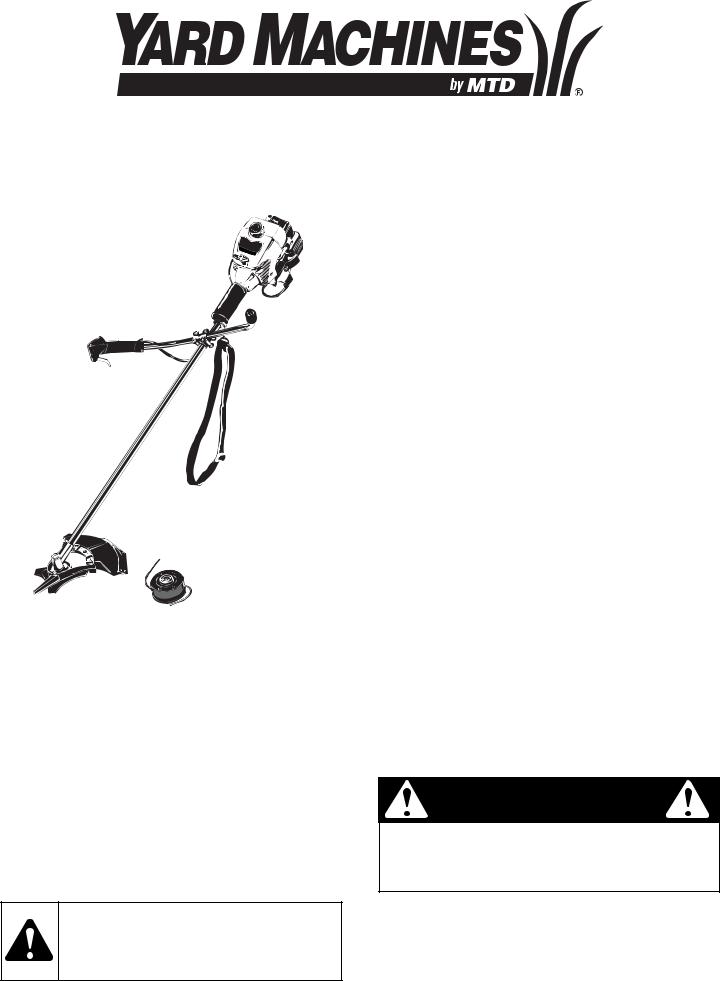
Operator’s Manual
TABLE OF CONTENTS
Service Information . . . . . . . . . . . . . . . . . . . . . . . . . . . . . .1 Rules for Safe Operation . . . . . . . . . . . . . . . . . . . . . . . . . .2 Oil and Fuel Information . . . . . . . . . . . . . . . . . . . . . . . . . . .3 Assembly Instructions . . . . . . . . . . . . . . . . . . . . . . . . . . . .4 Know Your Unit . . . . . . . . . . . . . . . . . . . . . . . . . . . . . . . . .4 Starting/Stopping Instructions . . . . . . . . . . . . . . . . . . . . . .7 Operating Instructions . . . . . . . . . . . . . . . . . . . . . . . . . . . .8 Maintenance and Repair Instructions . . . . . . . . . . . . . . . .9 Cleaning and Storage . . . . . . . . . . . . . . . . . . . . . . . . . . .13 Troubleshooting Chart . . . . . . . . . . . . . . . . . . . . . . . . . . .14 Specifications . . . . . . . . . . . . . . . . . . . . . . . . . . . . . . . . .15 Warranty Information . . . . . . . . . . . . . . . . . . . . . . . . .17, 18 Parts List . . . . . . . . . . . . . . . . . . . . . . . . . . . . . . . . . . . .E18
WARNING: When using the unit, you must follow the safety rules. Please read these instructions before operating the unit in order to ensure the safety of the operator and any bystanders. Please keep these instructions for later use.
2-Cycle Gasoline
Trimmer/Brushcutter
Y780
SAVE THESE INSTRUCTIONS
For service call 1-800-345-8746 in the United States, or 1-800-668-1238 in Canada to obtain a list of authorized service dealers near you. For more details about your unit, visit our website at www.mtdproducts.com.
DO NOT RETURN THE UNIT TO THE RETAILER. PROOF OF PURCHASE WILL BE REQUIRED FOR WARRANTY SERVICE.
THIS PRODUCT IS COVERED BY ONE OR MORE U.S. PATENTS. OTHER PATENTS PENDING.
Service on this unit both within and after the warranty period should be performed only by an authorized and approved service dealer.
SPARK ARRESTOR NOTE
NOTE: For users on U.S. Forest Land and in the states of California, Maine, Oregon and Washington. All U.S. Forest Land and the state of California (Public Resources Codes 4442 and 4443), Oregon and Washington require, by law that certain internal combustion engines operated on forest brush and/or grass-covered areas be equipped with a spark arrestor, maintained in effective working order, or the engine be constructed, equipped and maintained for the prevention of fire. Check with your state or local authorities for regulations pertaining to these requirements. Failure to follow these requirements could subject you to liability or a fine. This unit is factory equipped with a spark arrestor. If it requires replacement, ask your LOCAL SERVICE DEALER to install the
Accessory Part #753-05169 Spark Arrestor Kit.
CALIFORNIA PROPOSITION 65 WARNING
WARNING
THE ENGINE EXHAUST FROM THIS PRODUCT CONTAINS CHEMICALS KNOWN TO THE STATE OF CALIFORNIA TO CAUSE CANCER, BIRTH DEFECTS OR OTHER REPRODUCTIVE HARM.
All information, illustrations, and specifications in this manual are based on the latest product information available at the time of printing. We reserve the right to make changes at any time without notice.
Copyright© 2005 MTD SOUTHWEST INC, All Rights Reserved.
P/N 769-01949 |
(11/05) |

RULES FOR SAFE OPERATION
• IMPORTANT SAFETY INSTRUCTIONS •
READ ALL INSTRUCTIONS BEFORE OPERATING
•Read the instructions carefully. Be familiar with the controls and proper use of the unit.
•Do not operate this unit when tired, ill or under the influence of alcohol, drugs or medication.
•Children under the age of 15 must not use the unit; teens may operate the unit with adult guidance.
•Inspect the unit before use. Replace damaged parts. Check for fuel leaks. Make sure all fasteners are in place and secure. Replace cutting attachment parts that are cracked, chipped or damaged in any way. Make sure the cutting attachment is properly installed and securely fastened. Be sure that the cutting attachment shield is properly attached, and positioned as recommended. Failure to do so can result in personal injury to the operator and bystanders, as well as damage to the unit.
•Use only 0.095-inch (2.41 mm) diameter original equipment manufacturer replacement line. Never use metal-reinforced line, wire, chain or rope. These can break off and become dangerous projectiles.
•Be aware of risk of injury to the head, hands and feet.
•Squeeze the throttle control and check that it returns automatically to the idle position. Make all adjustments or repairs before using the unit.
•Clear the area to be cut before each use. Remove rocks, broken glass, nails, wire, string and other objects which may be thrown or become entangled in the cutting attachment. Clear the area of children, bystanders and pets; keep them outside a 50-foot (15 m.) radius, at a minimum. Even then, they are still at risk from thrown objects. Encourage bystanders to wear eye protection. If you are
approached, stop the unit immediately.
SAFETY WARNINGS FOR GAS UNITS
WARNING: Gasoline is highly flammable, and its vapors can explode if ignited. Take the following precautions:
•Add fuel in a clean, well-ventilated outdoor area where there are no sparks or flames. Remove the fuel cap slowly, and only after the engine stops. Do not smoke while fueling or mixing fuel. Wipe up any spilled fuel from the unit immediately.
•Store fuel only in containers specifically designed and approved for the storage of such materials.
•Always stop the engine and allow it to cool before filling the fuel tank. Never remove the fuel tank cap or add fuel when the engine is hot. Never operate the unit without the fuel cap securely in place. Loosen the fuel tank cap slowly to relieve any pressure in the tank.
•Avoid creating a source of ignition for spilled fuel. Do not start the engine until fuel vapors dissipate.
•Move the unit at least 30 feet (9.1 m) from the fueling source and site before starting the engine. Do not smoke. Keep sparks and open
flames away from the area while adding fuel or operating the unit.
WHILE OPERATING
•Never start or run the unit inside a closed room or building. Breathing exhaust fumes can be fatal. Operate this unit only in a well-ventilated outdoor area.
•Wear safety glasses or goggles that meet ANSI Z87.1 standards and are marked as such. Wear ear/hearing protection when operating this unit. Wear a face or dust mask if the operation is dusty.
•Wear heavy long pants, boots, gloves and a long sleeve shirt. Do not wear loose clothing, jewelry, short pants, sandals or go barefoot. Secure hair above shoulder level.
•The cutting attachment shield must always be in place while operating the unit as a trimmer. Do not operate unit without both trimming lines extended, and the proper line installed. Do not extend the trimming line beyond the length of the shield.
•This unit has a clutch. The cutting attachment remains stationary when the engine is idling. If it does not, have the unit adjusted by an authorized service technician.
•Adjust the bull-horn handlebar to your size in order to provide the best grip.
•Be sure the cutting attachment is not in contact with anything before starting the unit.
•Use the unit only in daylight or good artificial light.
•Avoid accidental starting. Be in the starting position whenever pulling the starter rope. Both the operator and unit must be in a stable position while starting. Refer to the Starting/Stopping Instructions.
•Use the right tool. Only use this tool for its intended purpose.
•Do not overreach. Always keep proper footing and balance.
•Always hold the unit with both hands when operating. Keep a firm grip on both handles or grips.
•Keep hands, face, and feet at a distance from all moving parts. Do not touch or try to stop the cutting attachment when it rotates.
•Do not touch the engine, gear housing or muffler. These parts get extremely hot from operation, even after the unit is turned off.
•Do not operate the engine faster than the speed needed to cut, trim or edge. Do not run the engine at high speed when not cutting.
•Always stop the engine when cutting is delayed or when walking from one cutting location to another.
•If you strike or become entangled with a foreign object, stop the engine immediately and check for damage. Do not operate before repairing damage. Do not operate the unit with loose or damaged parts.
•Stop the unit, switch the engine to off, and disconnect the spark plug for maintenance or repair.
•Use only original equipment manufacturer replacement parts and accessories for this unit. These are available from your authorized service dealer. Use of any non-original factory parts or accessories could lead to serious injury to the user, or damage to the unit, and void your warranty.
•Keep unit clean of vegetation and other materials. They may become lodged between the cutting attachment and shield.
•To reduce fire hazard, replace a faulty muffler and spark arrestor. Keep the engine and muffler free from grass, leaves, excessive
grease or carbon build up.
WHILE OPERATING WITH CUTTING BLADE
•Read and understand all safety warnings before operating this unit.
•Always use the shoulder harness when using the brush blade accessory.
•Keep the bull-horn handlebar between the operator and cutting attachment or blade at all times.
•NEVER cut when the cutting blade is 30 inches (76 cm) or more above the ground level.
•Blade thrust may occur when the spinning blade contacts an object that it does not immediately cut. Blade thrust can be violent enough to propel the unit and/or operator in any direction, possibly causing a loss of control. Blade thrust can occur without warning if the blade snags, stalls or binds. This is more likely to occur in areas where it is difficult to see the material being cut.
•For operation with the brush blade, do not cut anything thicker than 1/2 inch or a violent kickback could occur.
•Do not attempt to touch or stop the blade when it is rotating.
•A coasting blade can cause injury while it continues to spin after the engine is stopped or the throttle trigger is released. Maintain proper control until the blade has completely stopped rotating.
•Do not run the unit at high speed when not cutting.
•If you strike or become entangled with a foreign object, stop the engine immediately and check for damage. Have any damage repaired before attempting further operations. Do not operate unit with a bent, cracked or dull blade. Discard blades that are bent, warped, cracked or broken.
•Do not sharpen the cutting blade. Sharpening the blade can cause the blade tip to break off while in use. This can result in severe personal injury. Replace the blade.
•Do not use the cutting blade for edging or as an edger; severe personal injury to yourself or others may incur. Use the cutting blade only for the purpose as described in this manual.
•Stop the engine IMMEDIATELY if you feel excessive vibration.
Vibration is a sign of trouble. Inspect thoroughly for loose nuts, bolts or damage before continuing. Repair or replace affected parts as necessary.
AFTER USE
•Clean cutting blades with a household cleaner to remove any gum buildup. Oil the blade with machine oil to prevent rust.
•Lock up and store the cutting blade in an appropriate area to protect
2
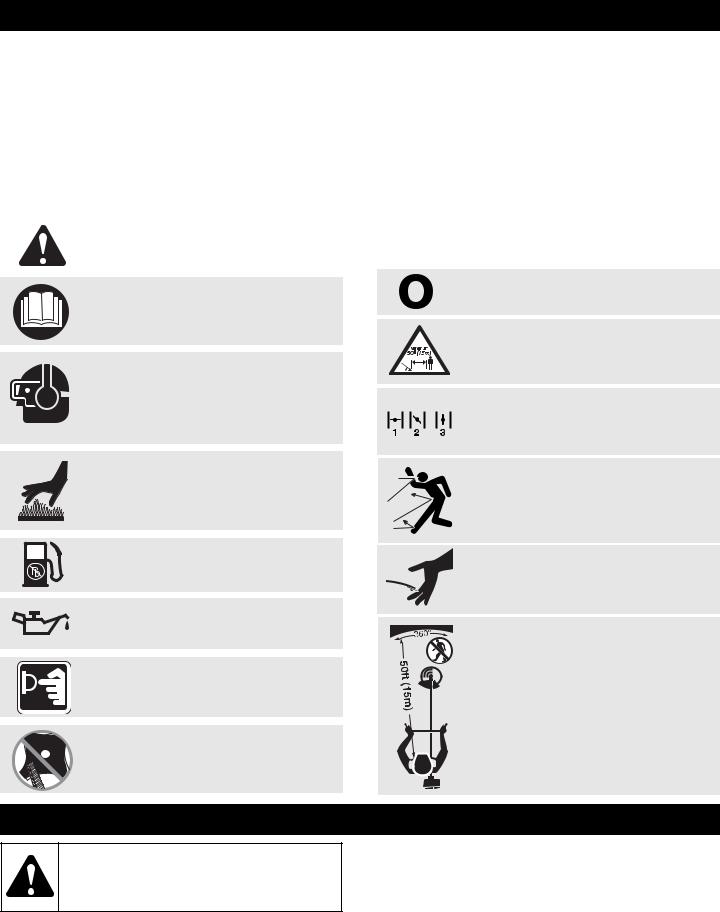
RULES FOR SAFE OPERATION
the blade from unauthorized use or damage.
OTHER SAFETY WARNINGS
•Never store a fueled unit inside a building where fumes may reach an open flame or spark.
•Allow the engine to cool before storing or transporting. Be sure to secure the unit while transporting.
•Store the unit in a dry area, locked up or up high to prevent unauthorized use or damage, out of the reach of children.
•Never douse or squirt the unit with water or any other liquid. Keep handles dry, clean and free from debris. Clean after each use, see Cleaning and Storage instructions.
•Keep these instructions. Refer to them often and use them to instruct other users. If you loan someone this unit, also loan them these instructions.
SAVE THESE INSTRUCTIONS
SAFETY AND INTERNATIONAL SYMBOLS
This operator's manual describes safety and international symbols and pictographs that may appear on this product. Read the operator's manual for complete safety, assembly, operating and maintenance and repair information.
SYMBOL |
MEANING |
SYMBOL |
MEANING |
|||
|
• SAFETY ALERT SYMBOL |
|
|
|
|
• ON/OFF STOP CONTROL |
|
|
|
|
|
||
|
Indicates danger, warning or caution. May be used |
|
|
|
|
ON / START / RUN |
|
in conjunction with other symbols or pictographs. |
|
|
|
|
|
|
|
|
|
|
|
|
|
|
|
|
|
|
|
•WARNING - READ OPERATOR'S MANUAL
Read the operator’s manual(s) and follow all warnings and safety instructions. Failure to do so can result in serious injury to the operator and/or bystanders.
•WEAR EYE AND HEARING PROTECTION
WARNING: Thrown objects and loud noise can cause severe eye injury and hearing loss. Wear eye protection meeting ANSI Z87.1 standards and ear protection when operating this unit. Use a full face shield when needed.
•HOT SURFACE WARNING
Do not touch a hot muffler, gear housing or cylinder. You may get burned. These parts get extremely hot from operation. They remain hot for a short time after the unit is turned off.
•ON/OFF STOP CONTROL
OFF or STOP
•KEEP BYSTANDERS AWAY
WARNING: Keep all bystanders, especially children and pets, at least 50 feet (15 m) from the operating area.
•CHOKE CONTROL
1.• FULL choke position
2.• PARTIAL choke position
3.• RUN choke position
•THROWN OBJECTS AND ROTATING CUTTER CAN CAUSE SEVERE INJURY
WARNING: Do not operate without the cutting attachment shield in place. Keep away from the rotating cutting attachment.
•UNLEADED FUEL
Always use clean, fresh unleaded fuel
•OIL
Refer to operator’s manual for the proper type of oil.
•PRIMER BULB
Push primer bulb, fully and slowly, 10 times.
•BRUSHCUTTERS •REPLACE DULL BLADE
Do not sharpen the cutting blade. Sharpening the blade can cause the blade tip to break off while in use. This can result in severe personal injury.
•SHARP BLADE
WARNING: Sharp blade on cutting attachment shield. To prevent serious injury, do not touch the line cutting blade.
•TRIMMER/ BRUSHCUTTER SAFETY
WARNING: Thrown objects and rotating cutter can cause severe injury. Keep bystanders, especially children and pets, at least 50 feet (15 m) away from the cutting area. The cutting attachment shield must be used when using the trimmer cutting attachment.
OIL AND FUEL INFORMATION
WARNING: Gasoline is extremely flammable. Ignited vapors may explode. Always stop the engine and allow it to cool before filling the fuel tank. Do not smoke while filling the tank. Keep sparks and open flames at a distance from the area.
OIL AND FUEL MIXING INSTRUCTIONS
Old and/or improperly mixed fuel are the main reasons for the unit not running properly. Be sure to use fresh (less than 60
days old), clean unleaded fuel. Follow the instructions carefully for the proper fuel/oil mixture.
To Obtain Correct Fuel Mix:
Thoroughly mix the proper ratio of 2-cycle engine oil with unleaded gasoline in a separate fuel can. Use a 40:1 fuel/oil ratio—one gallon (3.8 liters) of unleaded gasoline mixed with one 3.2 oz. (95 ml.) bottle of 2-cycle oil. Do not mix them directly in the engine fuel tank. See the Fuel Mixture Table for specific gas and oil mixing ratios.
3
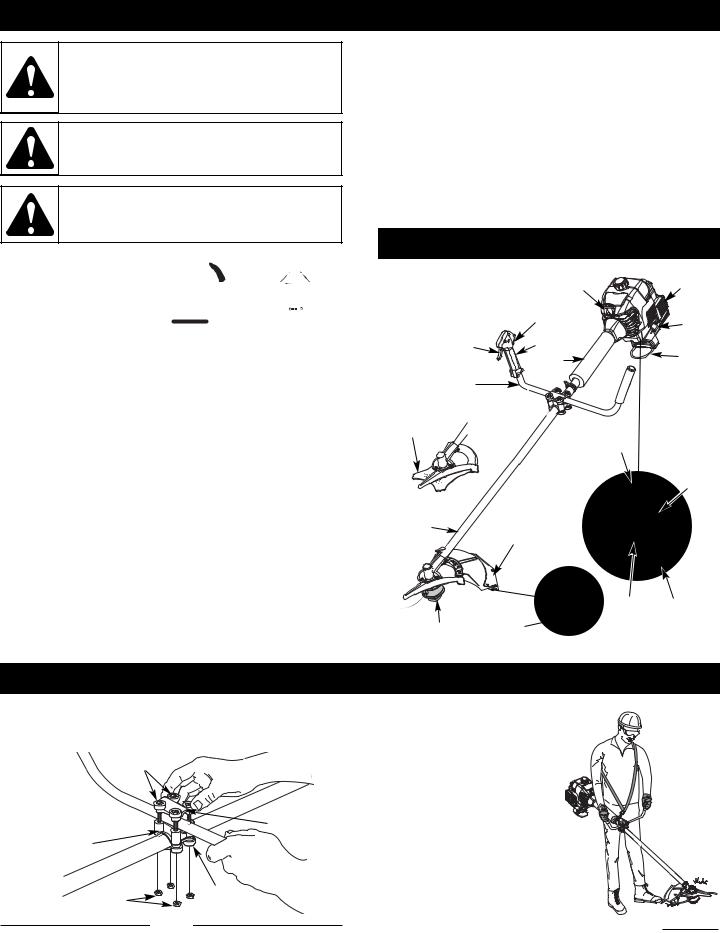
OIL AND FUEL INFORMATION
CAUTION: For proper engine operation and maximum reliability, pay strict attention to the oil and fuel mixing instructions on the 2-cycle oil container. Using improperly mixed fuel can severely damage the engine.
WARNING: Remove fuel cap slowly to avoid injury from fuel spray. Never operate the unit without the fuel cap securely in place.
WARNING: Add fuel in a clean, well ventilated outdoor area. Wipe up any spilled fuel immediately. Avoid creating a source of ignition for spilt fuel. Do not start the engine until fuel vapors dissipate.
Using Fuel Additives
The bottle of 2-cycle oil that came with your unit contains a fuel additive which will help inhibit corrosion and minimize the formation of gum deposits. It is recom-mended that you use our 2-cycle oil with this unit.
 +
+ 
UNLEADED GAS |
2-CYCLE OIL |
|
|
UNLEADED GAS |
2 CYCLE OIL |
1 GALLON US |
3.2 FL. OZ. |
(3.8 LITERS) |
(95 ml) |
1 LITER |
25 ml |
If unavailable, use a good 2-cycle oil designed for
air-cooled engines along with a fuel additive, such as STA-BIL® Gas Stabilizer or an equivalent. Add 0.8 oz. (23 ml.) of fuel additive per gallon of fuel according to the instructions on the container. NEVER add fuel additives directly to the unit's fuel tank.
NOTE: Dispose of the old fuel/oil mix in accordance to Federal, State and Local regulations.
Definition of Blended Fuels
Today's fuels are often a blend of gasoline and oxygenates such as ethanol, methanol, or MTBE (ether). Alcohol-blended fuel absorbs water. As little as 1% water in the fuel can make fuel and oil separate and leads to formation of acids during storage. When using alcohol-blended fuel, use fresh fuel.
Using Blended Fuels
If you choose to use a blended fuel, or its use is unavoidable, follow recommended precautions:
•Always use the fresh fuel mix explained in the operator's manual
•Always shake the fuel mix before fueling the unit
•Drain the tank and run the engine dry before storing the unit
Applications
As a trimmer, cutting grass and light weeds, and decorative trimming around trees, fences, etc.
As a brushcutter, cutting weeds and light bush of up to 13 mm (1/2 inch) in diameter
KNOW YOUR UNIT
Starter Rope Grip |
Muffler |
|
On/Off Stop |
Spark |
|
Control |
|
|
Throttle |
Plug |
Throttle |
|
|
Lock-Out |
|
|
Control |
Shaft |
Foot |
|
Stand |
|
|
Grip |
|
Bull Horn |
|
|
|
|
|
Handlebar |
|
|
Cutting
Blade
Fuel
Cap
Blue
Choke
Lever
Shaft |
Cutting |
Housing |
Attachment |
|
Shield |
|
Line |
Primer |
Air Filter/ |
|
Bulb |
Muffler |
|
Cutting |
Cutting |
|
Cover |
Attachment |
Blade |
|
|
ASSEMBLY INSTRUCTIONS
INSTALL AND ADJUST THE HANDLEBAR
1.Place the bull-horn handle between the top and middle clamp pieces (Fig. 1).
(4)Screws
|
Top |
|
Clamp |
Middle Clamp |
|
Nuts |
Bottom |
Clamp |
Fig. 1
2.While holding the three pieces together, install the four (4) screws through the top clamp and into middle clamp.
NOTE: The holes in the top and middle clamp will line up only when assembled correctly.
3.Place the clamps and the
handlebar over the shaft housing and onto the bottom clamp.
4. Hold each hex nut in the bottom clamp recess with a finger. Start screws with a large Phillips screwdriver. Do not tighten until you make the handle adjustment.
5. While holding the unit in the 

 operating position (Fig. 2),
operating position (Fig. 2), 


 move the handlebar to the
move the handlebar to the  location that provides you the
location that provides you the  best grip.
best grip.
6.Tighten the clamp screws evenly, until the handlebar is secure.
4
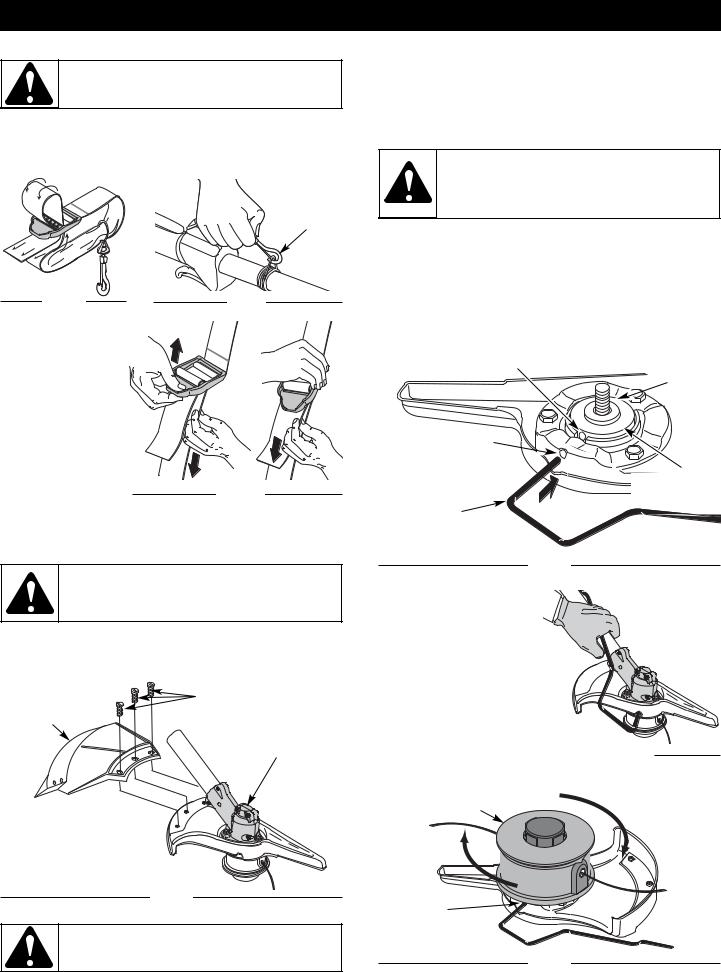
ASSEMBLY INSTRUCTIONS
INSTALL THE HARNESS
WARNING: Always use the shoulder harness when using the cutting blade to avoid serious personal injury.
Install the cutting attachment shield when using the unit as a grass trimmer
Install the cutting attachment shield on the shield mount by inserting the three (3) screws into the shield mount. Tighten securely with a flat blade screwdriver (Fig. 6).
1.Push the strap through the center of the buckle.
2.Pull the strap over the cross bar and down through the slot in the buckle (Fig. 3).
Support Fitting
Fig. 3 |
Fig. 4 |
3.Put the harness on over your head
and onto your shoulder. Snap it on to the support fitting (Fig. 4).
4.Adjust the length to fit the operator’s size. Pull the tab to
lengthen, pull the
strap to shorten Fig. 5 (Fig 5).
REMOVE AND INSTALL THE CUTTING SHIELD
Remove the cutting attachment shield when using the unit as a brushcutter
WARNING: The cutting attachment shield should NOT be installed when operating the unit with a blade. Remove the cutting attachment shield before removing or installing the blade.
Remove the cutting attachment shield from the shield mount by removing the three (3) screws with a flat blade screwdriver (Fig. 6). Store parts for future use.
Cutting |
(3) Screws |
|
Attachment |
||
|
||
Shield |
|
Gear Housing
Shield Mount 
Fig. 6
WARNING: To avoid serious personal injury, the cutting attachment shield MUST be in place at all times while operating the unit as a grass trimmer.
REMOVE THE CUTTING ATTACHMENT AND INSTALL THE CUTTING BLADE
WARNING: The gear housing gets hot with use. It can result in injury to the operator. The housing remains hot for a short time even after the unit is turned off. Do not touch the gear housing until it has cooled.
NOTE: To make cutting blade removal and installation easier, place the unit on the ground or on a work bench.
Remove the Cutting Attachment Shield
See Remove and Install the Cutting Attachment Shield.
Remove the Cutting Attachment
1.Align the shaft bushing hole with the locking rod slot and insert the locking rod into the shaft bushing hole (Fig. 7).
Shaft Bushing Hole
Output
 Shaft
Shaft
Locking Rod Slot
Output Shaft
Bushing
Locking Rod
Fig. 7
2.Hold the locking rod in
place by grasping it next to the boom of the unit (Fig. 8).
3.While holding the locking
rod, remove the cutting attachment by turning it clockwise off of the output shaft (Fig. 9). Store the cutting attachment for future use.
NOTE: The blade retainer |
|
|
|
Fig. 8 |
||
|
|
|
||||
under the cutting attach- |
|
|
|
|
||
|
|
|
|
|||
Cutting Attachment |
|
|
|
|
||
|
|
|
|
|
|
|
|
|
|
|
|
|
|
|
|
|
|
|
|
|
|
|
|
|
|
|
|
|
|
|
|
|
|
|
|
|
|
|
|
|
|
Locking Rod
Slot
Locking Rod 
Fig. 9
5
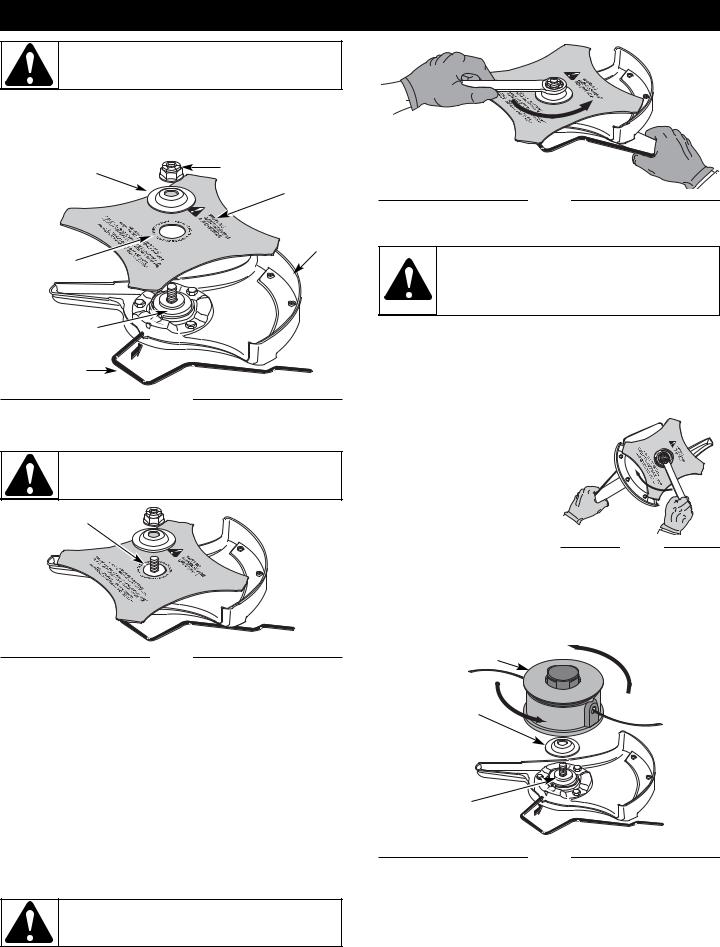
ASSEMBLY INSTRUCTIONS
WARNING: To avoid serious personal injury, always wear gloves while handling or installing the blade.
ment will be used when installing the cutting blade.
Install the Cutting Blade
4.Place the cutting blade on the output shaft bushing (Fig. 10).
Blade Retainer |
Nut |
Cutting
Blade
Shield
Mount
Pilot Hole
Output Shaft
Bushing
Locking Rod
Fig. 10
5.Make sure that the cutting blade is centered on the pilot step and sitting flat against the output shaft bushing (Fig. 11).
WARNING: If the cutting blade is off-center, the unit will vibrate and the blade may fly off, causing possible serious personal injury.
Pilot Step
Fig. 11
6.Align the shaft bushing hole with the locking rod slot and insert the locking rod into the bushing hole (Fig. 7).
7.Put the blade retainer and nut on the output shaft. Make sure that the blade is installed correctly.
8.Tighten nut counterclockwise against the blade while holding the locking rod:
•If using a torque wrench and an 13 mm socket, tighten to:
37 - 38 N•m, 325 - 335 in•lb, 27 - 28 ft.•lb.
•Without a torque wrench, use a 13 mm closed-end or socket wrench, turning the nut until the blade retainer is snug against the shaft bushing. Make sure that the blade is installed correctly, then rotate the nut an additional 1/4 to 1/2 turn counterclockwise (Fig. 12).
1/4-1/2 turn Counterclockwise
Fig. 12
REMOVE THE CUTTING BLADE AND INSTALL THE CUTTING ATTACHMENT
WARNING: Do not sharpen the cutting blade. Sharpening the blade can cause the blade tip to break off while in use. This can result in severe personal injury. Replace the blade.
Remove the Cutting Blade
1.Align the shaft bushing hole with the locking rod slot and insert the locking rod into the bushing hole (Fig. 7).
2.Hold the locking rod in place by grasping it next to the boom of the unit (Fig. 13).
3.While holding the locking rod, loosen the nut on the blade
by turning it clockwise with a
13 mm closed-end or socket Clockwise
wrench (Fig. 13).
4. Remove the nut, blade retainer and blade. Store the
nut and blade together for future use in a secure place.
Store out of children’s reach. 
Install the Cutting Attachment
Fig. 13
5.Align the shaft bushing hole
with the locking rod slot and insert the locking rod into the shaft bushing hole (Fig. 7). Place the blade retainer on the output shaft with the flat surface against the output shaft bushing as shown in Fig. 14. Screw the cutting attachment counterclockwise onto the output shaft. Tighten securely.
Cutting Attachment
Blade Retainer
Output Shaft
Bushing
Locking Rod 
Fig. 14
9.Remove the locking rod from the locking rod slot.
WARNING: To avoid serious personal injury or damage to the unit, do not start or operate this unit with the locking rod in the locking rod slot.
NOTE: The blade retainer must be installed on the output shaft in the position shown for the cutting attachment to work correctly.
6.Remove the locking rod.
7.Install the cutting attachment shield. Refer to Remove and Install the Cutting Attachment Shield.
6
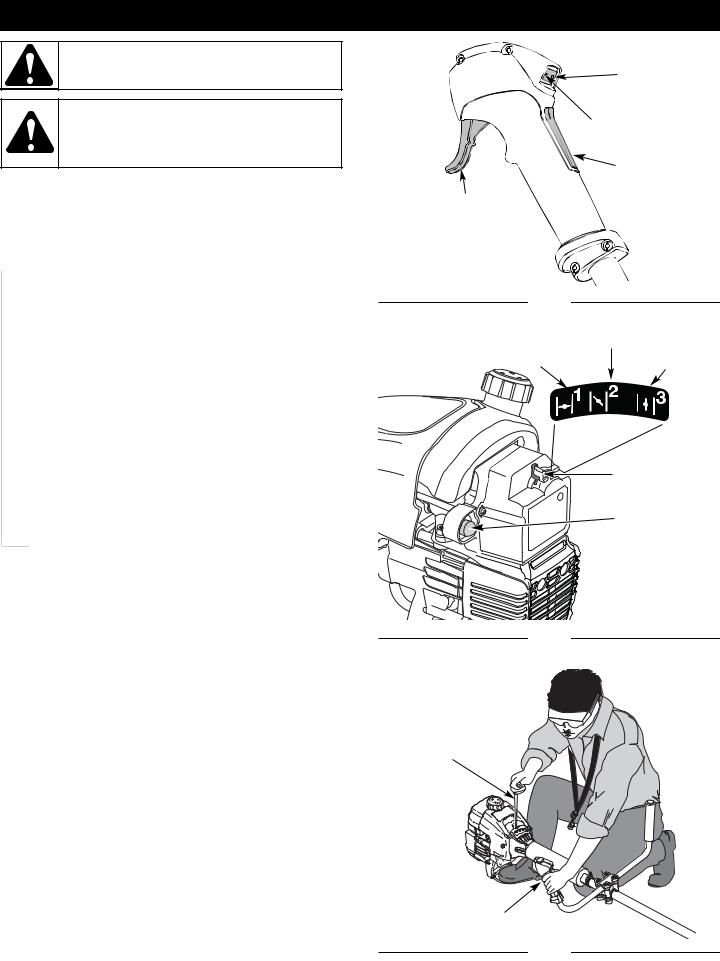
STARTING / STOPPING INSTRUCTIONS
WARNING: Operate this unit only in a wellventilated outdoor area. Carbon monoxide exhaust fumes can be lethal in a confined area.
WARNING: Avoid accidental starting. Make sure you are in the starting position when pulling the starter rope (Fig. 17). To avoid serious injury, both the operator and unit must be in a stable position while starting.
STARTING INSTRUCTIONS
1.Mix gas with oil. Fill gas tank with gas/oil mixture. See Oil and Gasoline Mixing Instructions.
2.Verify the On/Off Stop Control is in the ON (I) position (Fig. 15).
 3. Fully press and release the primer bulb 10 times, slowly. Some amount of gas should be visible in the primer bulb and gas lines (Fig. 16). If you can’t see gas in the bulb, press and release the bulb as many times as it takes before you can see gas in it.
3. Fully press and release the primer bulb 10 times, slowly. Some amount of gas should be visible in the primer bulb and gas lines (Fig. 16). If you can’t see gas in the bulb, press and release the bulb as many times as it takes before you can see gas in it.
4.Place the blue choke lever in Position 1 (Fig. 16).
5.With the unit on the ground, place one foot on the metal foot stand to hold the unit in place (Fig. 17). Press the throttle lock-out while you squeeze the throttle control. Pull the starter rope up to 5 times.
6.Place the blue choke lever in Position 2 (Fig. 16).
7.While continuing to squeeze the throttle lock-out and throttle control, pull the starter rope briskly until the engine starts.
8.Keep squeezing the throttle lock-out and the throttle control for 15 to 30 seconds to warm up the engine.
9.Release the throttle control and throttle lock-out, and
let idle.
10.Place the blue choke lever in Position 3 (Fig. 16). The unit is ready for use.
IF... The engine does not start, go back to step 3.
IF... The engine fails to start after a few attempts, place the blue choke lever in Position 3 and squeeze the throttle control. Pull the starter rope briskly 3 to 8 times. The engine should start. If not, repeat.
IF WARM... If the engine is already warm, make sure the On/Off Stop control is in the ON position and start the unit with the blue choke lever in Position 2. After the unit starts, move the blue choke lever to Position 3.
STOPPING INSTRUCTIONS
1.Release your hand from the throttle control. Allow the engine to cool down by idling.
2.Put the On/Off Stop Control in the OFF (O) position.
Throttle
Control
Fig. 15
Position 1
Fig. 16
Starting
Position
Starter Rope
Throttle Control
(Squeezed)
Fig. 17
Stop/Off (O)
Start/On (I)
Throttle
Lock-Out
Position 2
Position 3
Blue Choke
Lever
Primer Bulb
7
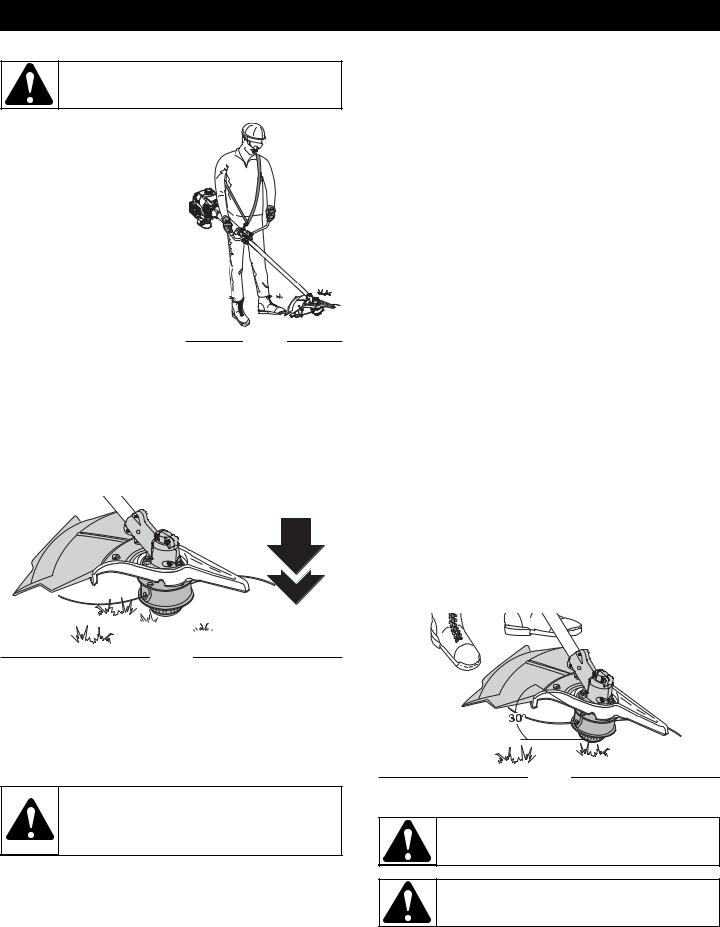
OPERATING INSTRUCTIONS
HOLDING THE TRIMMER
WARNING: Always wear eye, hearing, foot and body protection to reduce the risk of injury when operating this unit.
Before operating the unit, stand in the operating position (Fig. 18). Check for the following:
• The operator is wearing eye protection and proper clothing
• With a straight right arm, the operator’s right hand is holding the shaft grip
• The operator’s left arm is slightly-bent, the left hand holding the handle
• |
The unit is at waist level |
|
• |
The cutting attachment is |
|
|
parallel to the ground and |
Fig. 18 |
|
easily contacts the grass |
|
|
without the need to bend over |
|
Once you are in the operating position, hook the shoulder strap to the unit.
ADJUSTING TRIMMING LINE LENGTH
The Bump Head™ cutting attachment allows you to release trimming line without stopping the engine. To release more line, lightly tap the cutting attachment on the ground (Fig. 19) while operating the trimmer at high speed.
Fig. 19
NOTE: Always keep the trimming line fully extended. Line release becomes more difficult as the cutting line becomes shorter.
Each time the head is bumped, about 25.4 mm (1 inch) of trimming line is released. A blade in the cutting attachment shield will cut the line to the proper length if excess line is released.
CAUTION: Do not remove or alter the line cutting blade assembly. Excessive line length will make the clutch overheat. This may lead to serious personal injury or damage to the unit.
For best results, tap the Bump Head™ on bare ground or hard soil. If line release is attempted in tall grass, the engine may stall. Always keep the trimming line fully extended. Line release becomes more difficult as the cutting line becomes shorter.
NOTE: Do not rest the Bump Head™ on the ground while the unit is running.
Some line breakage will occur from:
•Entanglement with foreign matter
•Normal line fatigue
•Attempting to cut thick, stalky weeds
•Forcing the line into objects such as walls or fence posts
TIPS FOR BEST TRIMMING RESULTS
•For best trimming results, operate unit at full throttle.
•Keep the cutting attachment parallel to the ground.
•Do not force the cutting attachment. Allow the tip of the line to do the cutting, especially along walls. Cutting with more than the tip will reduce cutting efficiency and may overload the engine.
•Cut grass over 203mm (8 inches) by working from top to bottom in small increments to avoid premature line wear or engine drag.
•Cut from left to right whenever possible. Cutting to the right improves the unit's cutting efficiency. Clippings are thrown away from the operator.
•Slowly move the trimmer into and out of the cutting area at the desired height. Move either in a forward-backward or side-to-side motion. Cutting shorter lengths produces the best results.
•Trim only when grass and weeds are dry.
•The life of your cutting line is dependent upon:
•Proper adherence of trimming techniques (explained above)
•What vegetation is cut
•Where vegetation is cut
For example, the line will wear faster when trimming against a foundation wall as opposed to trimming around a tree.
DECORATIVE TRIMMING
Decorative trimming is accomplished by removing all vegetation around trees, posts, fences and more.
Rotate the whole unit so that the cutting attachment is at a 30° angle to the ground (Fig. 20).
Fig. 20
USING THE CUTTING BLADE
WARNING: Always wear eye, hearing, foot, body protection and the shoulder strap to reduce the risk of injury when operating this unit.
WARNING: Do not use the cutting blade for edging or as an edger. Severe personal injury to yourself or others can result.
Before operating the unit with the cutting blade, stand in the operating position (Fig. 21). Refer to Holding the Trimmer.
8
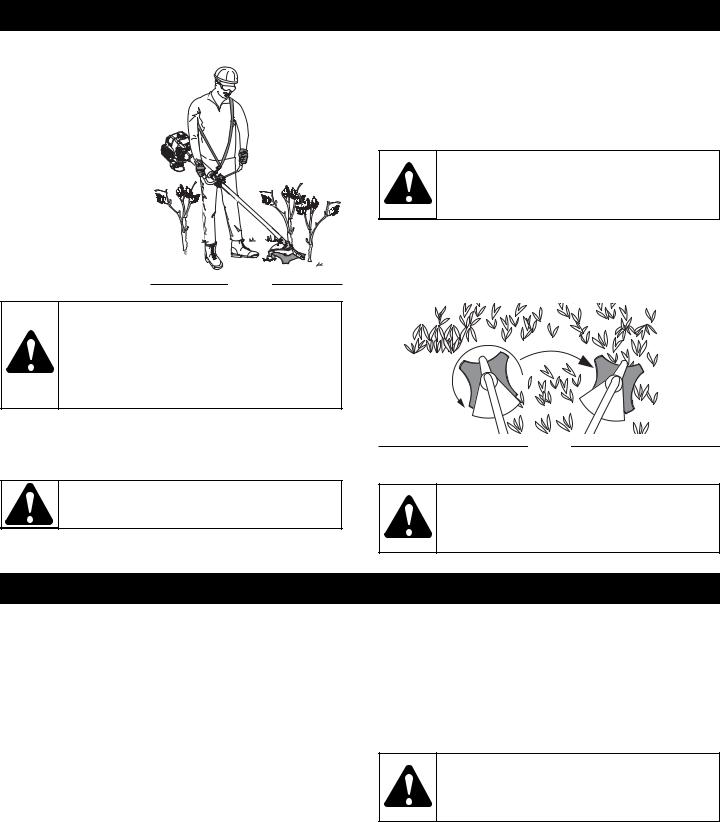
OPERATING INSTRUCTIONS
Cutting Blade Operating Tips
To establish a rhythmic cutting procedure:
• Plant feet firmly, comfortably apart.
• Bring the engine to full throttle before entering the material to be cut. At full throttle the blade has maximum cutting power and is less likely to bind, stall
•Swing the unit in the opposite direction as the blade spins, which increases the cutting action.
•After the return swing, move forward to the next area to be cut plant your feet again.
•The cutting blade is designed with a second cutting edge. You can use it by removing the blade, turning it upside down, and reinstalling it.
WARNING: Do not sharpen the cutting blade. Sharpening the blade can cause the blade tip to break off while in use. This can result in severe personal injury to yourself or others. Replace the blade.
or cause blade thrust |
|
To reduce the chance of material wrapping around the blade, |
||
(which can result in |
|
follow these steps: |
||
serious personal injury |
|
• |
Cut at full throttle |
|
to the operator or |
Fig. 21 |
• |
Swing the unit into material to be cut from your left to your |
|
others). |
||||
|
right (Fig. 22) |
|||
|
|
|
||
CAUTION: Blade thrust may occur when the spinning blade contacts an object that it does not immediately cut. Blade thrust can be violent enough to cause the unit and/or operator to be propelled in any direction, and possibly lose control of the unit. Blade thrust can occur without warning if the blade snags, stalls or binds. This is more likely to occur in areas where it is difficult to see the material being cut.
•Cut while swinging the upper part of your body from left to right
•Always release the throttle trigger and allow the engine to return to idle speed when not cutting.
WARNING: The blade continues to spin after the engine is turned off. The coasting blade can seriously cut you if accidentally touched.
•When you are finished, always unsnap the unit from the harness before taking off the harness.
Fig. 22
• Avoid the material just cut as you make the return swing
CAUTION: Do not clear away any cut material with the engine running or blade turning. To avoid serious personal injury, turn off the engine. Allow the blade to stop before removing materials wrapped around the blade shaft.
MAINTENANCE AND REPAIR INSTRUCTIONS
MAINTENANCE SCHEDULE
Perform these required maintenance procedures at the frequency stated in the table. These procedures should also be a part of any seasonal tune-up.
NOTE: Some maintenance procedures may require special tools or skills. If you are unsure about these procedures take your unit to any non-road engine repair establishment, individual or authorized service dealer.
NOTE: Maintenance, replacement, or repair of the emission control devices and system may be performed by any non-road engine repair establishment, individual or authorized service dealer.
In order to assure peak performance of your engine, inspection of the engine exhaust port may be necessary after 50 hours of operation. If you notice lost RPM, poor performance or general lack of acceleration, this service may be required. If you feel your engine is in need of this inspection, refer service to any non-road engine repair establishment, individual or authorized service dealer for repair. DO NOT attempt to perform this process yourself as engine damage may result from contaminants involved in the cleaning process for the port.
WARNING: To prevent serious injury, never perform maintenance or repairs with unit running. Always service and repair a cool unit. Disconnect the spark plug wire to ensure that the unit cannot start.
FREQUENCY |
MAINTENANCE REQUIRED |
REFER TO |
|
|
|
|
|
Before starting engine |
Fill fuel tank with fresh fuel |
Page 3, 4 |
|
|
|
|
|
Every 10 hours |
Clean and re-oil air filter |
Page 11 |
|
|
|
|
|
Every 25 hours |
Check and clean spark arrestor |
Page 12 |
|
Check spark plug condition and gap |
Page 13 |
||
|
|||
|
|
|
|
Every 50 hours |
Inspect exhaust port and spark arrestor screen for clogging or |
Page 12 |
|
obstruction to assure maximum performance levels |
|||
|
|
||
|
|
|
9
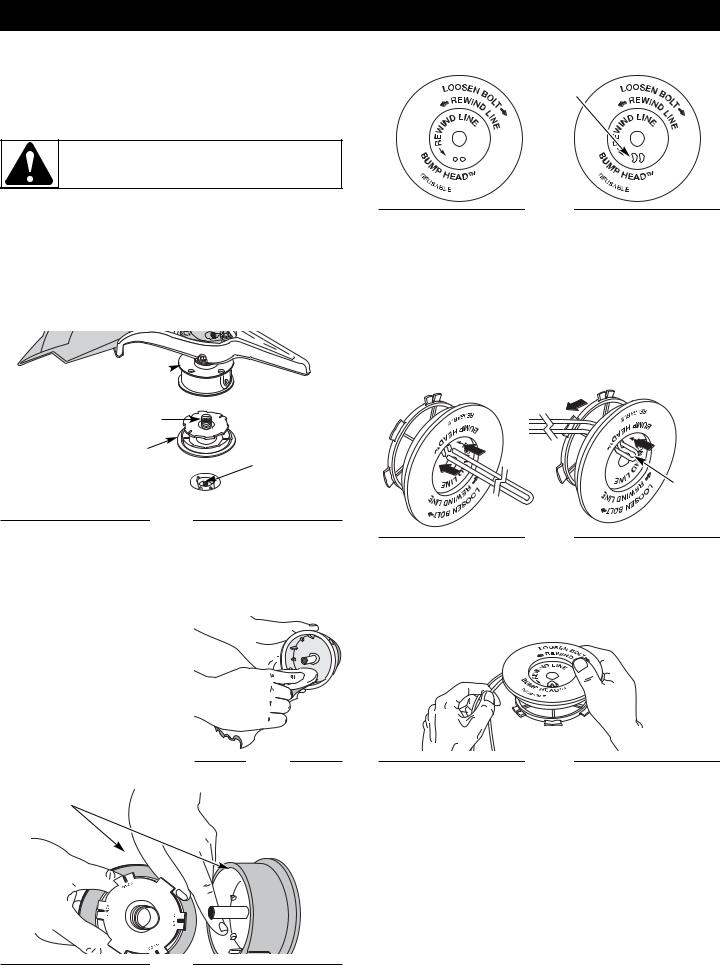
MAINTENANCE AND REPAIR INSTRUCTIONS
LINE INSTALLATION
This section covers both SplitLine™ and standard single line installation.
Always use original equipment manufacturer 2.41 mm
(0.095 inch) replacement line. Line other than the specified may make the engine overheat or fail.
WARNING: Never use metal-reinforced line, wire, chain or rope. These can break off and become dangerous projectiles.
There are two methods to replace the trimming line:
• Wind the inner reel with new line
For Use with Single |
For Use with SplitLine™ |
Line ONLY |
or Single Line |
|
Slotted |
|
Holes |
Fig. 26
• Install a prewound inner reel
Winding the Existing Inner Reel
1.Hold the outer spool with one hand and unscrew the Bump Knob clockwise (Fig. 23). Inspect the bolt inside the bump knob to make sure it moves freely. Replace the bump knob if damaged.
Outer Spool
Spring
Inner Reel
Bolt
Bump Knob 

Fig. 23
2.Remove the inner reel from the outer spool (Fig. 23).
3.Remove spring from the inner reel (Fig. 23).
4.Use a clean cloth to clean the the inner reel, spring, shaft and inner surface of the outer spool (Fig. 24).
5.Check the indexing teeth on the inner reel and outer
spool for wear (Fig. 25). If necessary, remove burrs or replace the reel and spool.
NOTE: SplitLine™ can only be used with the inner reel with the slotted holes. Single line can be used on either type of inner reel. Use Figure 26
to identify the inner reel you Fig. 24 have.
Indexing Teeth
NOTE: Always use the correct line length when installing trimming line on the unit. The line may not release properly if the line is too long.
Single Line Installation
Go To Step 8 for SplitLine™ Installation
6.Take approximately 5 m (16 feet) of new trimming line, loop it into two equal lengths. Insert each end of the line through one of the two holes in the inner reel (Fig. 27). Pull the line through the inner reel so that the loop is as small as possible.
Loop
Fig. 27
7.Wind the lines in tight even layers, onto the reel (Fig. 28). Wind the line in the direction indicated on the inner reel. Place your index finger between the two lines to stop the lines from overlapping. Do not overlap the ends of the line. Proceed to step 12.
Fig. 28
SplitLine™ Installation
8.Take approximately 2.5 m (8 feet) of new trimming line. Insert one end of the line through one of the two holes in the inner reel (Fig. 29). Pull the line through the inner reel until only about 4 inches is left out.
9.Insert the end of the line into the open hole in the inner reel and pull the line tight to make the loop as small as possible (Fig. 29).
10.Before winding, split the line back about 6 inches.
11.Wind the line in tight even layers in the direction indicated on the inner reel.
Fig. 25
10
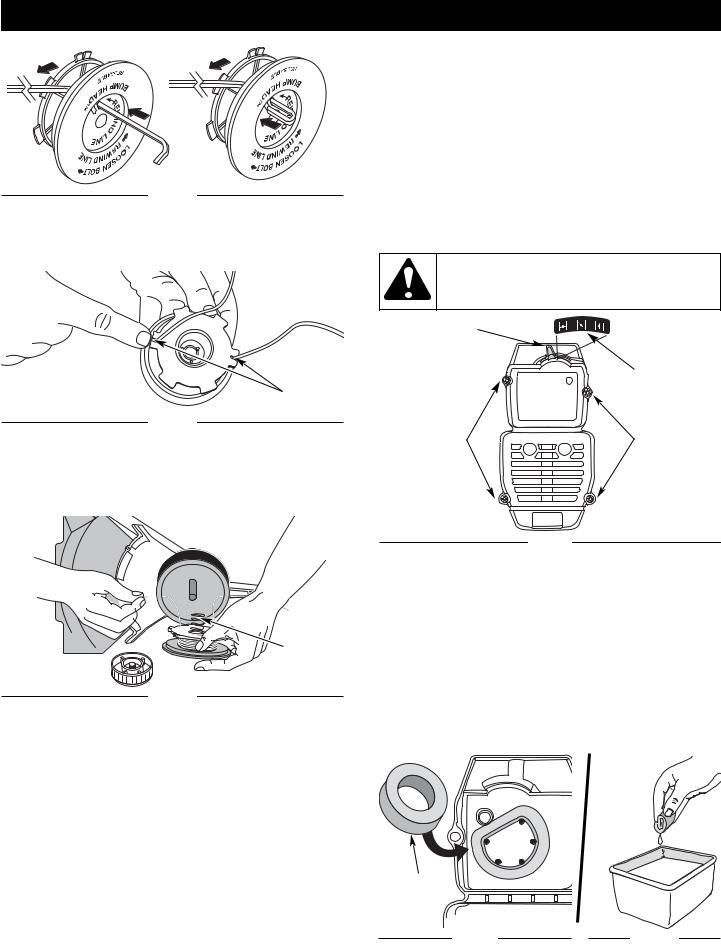
MAINTENANCE AND REPAIR INSTRUCTIONS
Fig. 29
NOTE: Failure to wind the line in the direction indicated will cause the cutting attachment to operate incorrectly.
12. Insert the ends of the line into the two holding slots (Fig. 30).
Holding Slots
Fig. 30
13.Insert the ends of the line through the eyelets in the outer spool and place inner reel with spring inside the outer spool (Fig. 31). Push the inner reel and outer spool together. While holding the inner reel and outer spool, grasp the ends and pull firmly to release the line from the holding slots in the reel.
Spring
Fig. 31
NOTE: The spring must be assembled on the inner reel before reassembling the cutting attachment.
14.Hold the inner reel in place and install the bump knob by turning counterclockwise. Tighten securely.
INSTALLING A PREWOUND REEL
1.Hold the outer spool with one hand and unscrew the bump knob clockwise (Fig. 23). Inspect the bolt inside the bump knob to make sure it moves freely. Replace the bump knob if damaged.
2.Remove the old inner reel from the outer spool (Fig. 23).
3.Remove the spring from the old inner reel (Fig. 23).
4.Place the spring in the new inner reel.
NOTE: The spring must be assembled on the inner reel before reassembling the cutting attachment.
5.Insert the ends of the line through the eyelets in the outer spool (Fig. 31).
6.Place the new inner reel inside the outer spool. Push the inner reel and outer spool together. While holding the inner reel and outer spool, grasp the ends and pull firmly to release the line from the holding slots in the spool.
7.Hold the inner reel in place and install the bump knob by turning counterclockwise. Tighten securely.
AIR FILTER MAINTENANCE
Removing the Air Filter/Muffler Cover
1.Place the choke lever in Position 2.
NOTE: The choke lever must be in Position 2 (Fig. 32) to remove the air filter/ muffler cover.
2.Remove the four (4) screws securing the air filter/muffler cover (Fig. 32). Use a flat blade or T20 Torx bit screwdriver.
WARNING: To prevent serious personal injury, always turn your trimmer off and allow it to cool before you clean or service it.
Blue Choke
Lever
Position 2
Screws |
Screws |
Fig. 32
3.Pull the cover from the engine. Do not force.
Cleaning the Air Filter
Clean and re-oil the air filter every 10 hours of operation. It is an important item to maintain. Failure to maintain the air filter will VOID the warranty.
1.Remove air filter/muffler cover. Refer to Removing the Air Filter/Muffler Cover.
2.Turn cover over and look inside to locate the air filter. Remove the air filter from inside the air filter/muffler cover (Fig. 33).
3.Wash the filter in detergent and water (Fig. 34). Rinse the filter thoroughly. Squeeze out excess water. Allow to dry completely.
Air Filter
Inside Muffler |
|
Cover |
|
Fig. 33 |
Fig. 34 |
11
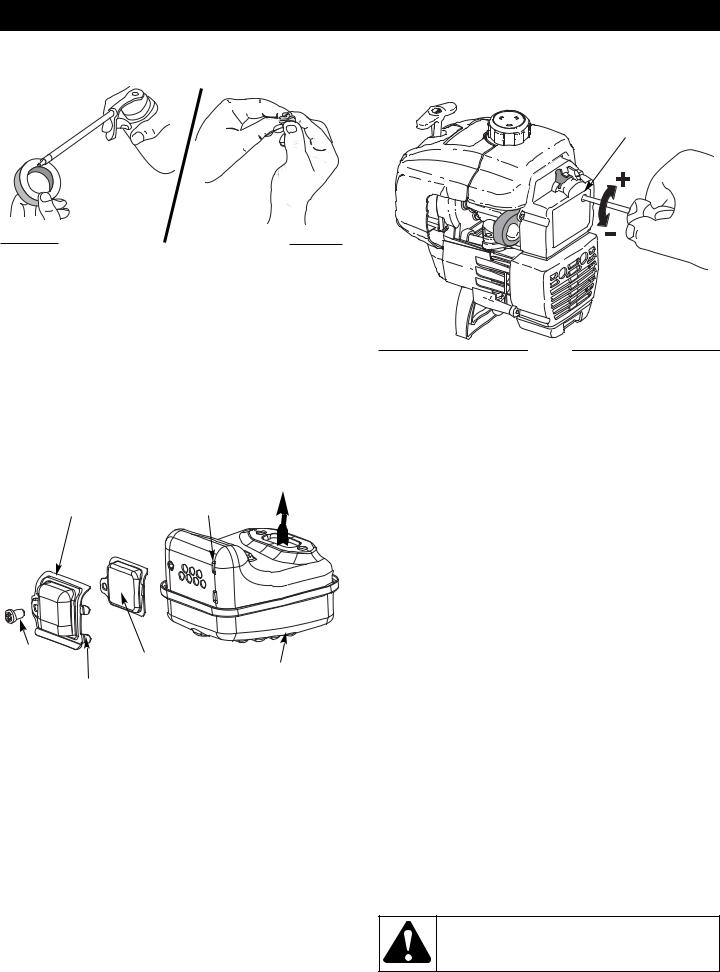
MAINTENANCE AND REPAIR INSTRUCTIONS
4.Apply enough clean SAE 30 oil to lightly coat the filter (Fig. 35).
5.Squeeze the filter to spread and remove excess oil (Fig. 36).
CARBURETOR ADJUSTMENT
The idle speed of the engine is adjustable through the air filter/ muffler cover (Fig. 38).
Idle Speed Screw
Fig. 35 |
|
|
|
Fig. 36 |
|
|
|
||
|
|
|
|
|
6.Replace the air filter inside the air filter/muffler cover (Fig. 33).
NOTE: Operating the unit without the air filter and air filter/ muffler cover assembly will VOID the warranty.
Reinstalling the Air Filter/Muffler Cover
1.Place the air filter/muffler cover over the back of the carburetor and muffler. Align the screw holes.
2.Insert the four (4) screws into the holes in the air filter/muffler cover (Fig. 32) and tighten. Do not over tighten.
SPARK ARRESTOR MAINTENANCE
1.Remove air filter/muffler cover. Refer to Removing the Air Filter/Muffler Cover.
2.Locate the muffler, but do not remove it. Find the screw on the bottom of the muffler (Fig. 37). Remove the screw using either a torx #20 or flat blade screwdriver.
Engine
Fig. 38
NOTE: Careless adjustments can seriously damage your unit. An authorized service dealer should make carburetor adjustments.
Check Gasoline Mixture
Old and/or improperly mixed gasoline is usually the reason for improper unit performance. Drain and refill the tank with fresh, properly-mixed gasoline prior to making any adjustments.
Refer to Oil and Gasoline Information.
Clean Air Filter
Spark Arrestor |
Slots |
Hood |
Screw
|
Spark Arrestor |
Muffler |
||
Tabs |
|
Screen |
||
|
|
|
|
|
|
|
|
|
|
|
|
Fig. 37 |
|
|
|
|
|
|
|
|
|
|
|
|
3.Carefully pry up the left side spark arrestor hood. Two tabs act as hinges on the right side of the hood. Flip open the spark arrestor hood like a door and then pull its tabs out of the muffler slots.
4.Using a small flat blade screwdriver, carefully pry the spark arrestor screen out from the inside of the spark arrestor hood.
5.Clean the spark arrestor screen with a wire brush. Replace it if it is damaged, or if you are unable to clean it thoroughly.
6.Reinstall the spark arrestor screen snugly back into the spark arrestor hood.
7.Reinstall the two hood tabs into the two muffler slots and flip the spark arrestor hood closed.
8.Replace the screw you removed in Step 2 and tighten it securely.
9.Reinstall the air filter/muffler cover.
The condition of the air filter is important to the operation of the unit. A dirty air filter will restrict air flow and change the air/gasoline mixture. This is often mistaken for an out of adjustment carburetor. Check the condition of the air filter before adjusting the idle speed screw. Refer to Air Filter Maintenance.
Adjust Idle Speed Screw
If, after checking the gasoline mixture and cleaning the air filter, the engine still will not idle, adjust the idle speed screw as follows:
1.Start the engine and let it run at a high idle for a minute to warm up. Refer to Starting/Stopping Instructions.
2.Release the throttle trigger and let the engine idle. If the engine stops, insert a small phillips or flat blade screwdriver into the hole in the air filter/muffler cover (Fig. 38). Turn the idle speed screw in, clockwise, 1/8 of a turn at a time (as needed) until the engine idles smoothly.
NOTE: The cutting attachment should not rotate when the engine idles.
3.If the cutting attachment rotates when the engine idles, turn the idle speed screw counterclockwise 1/8 of a turn at a time (as needed), to reduce idle speed.
Checking the gasoline mixture, cleaning the air filter, and adjusting the idle speed should solve most engine problems. If not and all of the following are true:
•the engine will not idle
•the engine hesitates or stalls on acceleration
•there is a loss of engine power
Have the carburetor adjusted by an authorized service dealer.
WARNING: The cutting attachment may spin during idle speed adjustments. Wear protective clothing and observe all safety instructions to prevent serious personal injury.
12
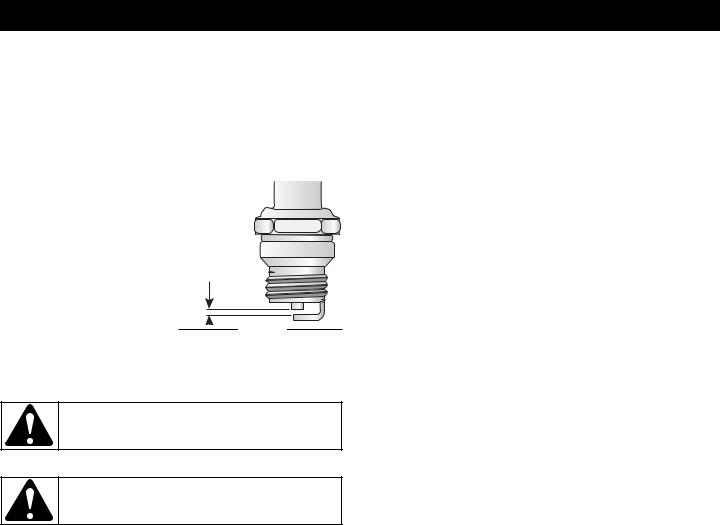
MAINTENANCE AND REPAIR INSTRUCTIONS
REPLACING THE SPARK PLUG
Use a Champion RDJ7Y spark plug, or equivalent. The correct air gap is 0.5 mm (0.020 in.). Remove the plug after every 25 hours of operation and check its condition.
1.Stop the engine and allow it to cool. Grasp the plug wire firmly and pull it from the spark plug.
2.Clean around the spark plug. Remove the spark plug from the cylinder head by turning a 5/8-inch socket counterclockwise.
3.Replace a cracked, fouled or dirty spark plug. Set the air gap at 0.5 mm (0.020 in.) using a feeler gauge (Fig. 37).
4.Install a correctly-gapped spark plug in the cylinder head. Tighten by turning the 5/8-inch socket clockwise until snug.
If using a torque wrench torque to:
12.3-13.5 N•m (110-120 in•lb) Do not over tighten.
0.020 in.
(0.5 mm.)
Fig. 37
CAUTION: Do not sand blast, scrape or clean electrodes. Grit in the engine could damage the cylinder.
CLEANING
STORAGE
•Never store a fueled unit where fumes may reach an open flame or spark.
•Allow the engine to cool before storing.
•Store the unit locked up to prevent unauthorized use or damage.
•Store the unit in a dry, well-ventilated area.
•Store the unit out of the reach of children.
LONG TERM STORAGE
If you plan on storing the unit for an extended time, use the following storage procedure:
1.Drain all gas from the gas tank into a container with the same 2-cycle gas mixture. Do not use gas that has been stored for more than 60 days. Dispose of the old gas/oil mix in accordance to Federal, State and Local regulations.
2.Start the engine and allow it to run until it stalls. This ensures that all gas has been drained from the carburetor.
3.Allow the engine to cool. Remove the spark plug and put 30 ml (1 oz) of any high quality motor oil or 2-cycle oil into the cylinder. Pull the starter rope slowly to distribute the oil. Reinstall the spark plug.
NOTE: Remove the spark plug and drain all of the oil from the cylinder before attempting to start the trimmer after storage.
4.Thoroughly clean the unit and inspect it for any loose or damaged parts. Repair or replace damaged parts and tighten loose screws, nuts or bolts. The unit is ready for storage.
WARNING: To avoid serious personal injury, always turn your trimmer off and allow it to cool before you clean or service it.
Use a small brush to clean off the outside of the unit. Do not use strong detergents. Household cleaners that contain aromatic oils such as pine and lemon, and solvents such as kerosene, can damage plastic housing or handle. Wipe off any moisture with a soft cloth.
TRANSPORTING
•Allow the engine to cool before transporting.
•Drain gas from unit.
•Tighten gas cap before transporting.
•Secure the unit while transporting.
13
TROUBLESHOOTING |
||
|
|
|
|
|
|
ENGINE WILL NOT START |
|
|
|
|
|
C A U S E |
|
A C T I O N |
Empty fuel tank |
|
Fill fuel tank with new fuel |
Primer bulb wasn't pressed enough |
|
Press primer bulb fully and slowly 10 times |
Engine is flooded |
|
Use starting procedure with choke lever in position 3 |
Old or improperly mixed fuel |
|
Drain gas tank and add fresh fuel |
Fouled spark plug |
|
Replace or clean the spark plug |
Plugged spark arrestor |
|
Clean or replace spark arrestor |
|
|
|
ENGINE WILL NOT IDLE |
|
|
|
|
|
C A U S E |
|
A C T I O N |
Air filter is plugged |
|
Replace or clean the air filter |
Old or improperly mixed fuel |
|
Drain gas tank and add fresh fuel |
Improper carburetor adjustment |
|
Adjust carburetor |
|
|
|
ENGINE WILL NOT ACCELERATE |
|
|
|
|
|
C A U S E |
|
A C T I O N |
Old or improperly mixed fuel |
|
Drain gas tank and add fresh fuel |
Improper carburetor adjustment |
|
Take to an authorized service dealer for adjustment |
Cutting attachment bound with grass |
|
Stop the engine and clean the cutting attachment |
Dirty air filter |
|
Clean or replace the air filter |
Plugged spark arrestor |
|
Clean or replace spark arrestor |
|
|
|
ENGINE LACKS POWER OR STALLS WHEN CUTTING |
|
|
|
|
|
C A U S E |
|
A C T I O N |
Old or improperly mixed fuel |
|
Drain gas tank and add fresh fuel |
Improper carburetor adjustment |
|
Take to an authorized service dealer for adjustment |
Fouled spark plug |
|
Replace or clean the spark plug |
Plugged spark arrestor |
|
Clean or replace spark arrestor |
|
|
|
CUTTING ATTACHMENT WILL NOT ADVANCE LINE |
|
|
|
|
|
C A U S E |
|
A C T I O N |
Cutting attachment bound with grass |
|
Stop the engine and clean cutting attachment |
Cutting attachment out of line |
|
Refill with new line |
Inner reel bound up |
|
Replace the inner reel |
Cutting head dirty |
|
Clean inner reel and outer spool |
Line welded |
|
Disassemble, remove the welded section and rewind |
Line twisted when refilled |
|
Disassemble and rewind the line |
Not enough line is exposed |
|
Push the bump knob and pull out line until 4 inches (102 mm) |
|
|
of line is outside of the cutting attachment |
|
|
|
CUTTING LINE ADVANCES UNCONTROLLABLY |
|
|
|
|
|
C A U SE |
|
A C T I O N |
Oil, cleaner or lubricant in cutting head |
|
Clean and thoroughly dry the cutting head |
|
|
|
If further assistance is required, contact your authorized service dealer.
14
SPECIFICATIONS |
|
|
|
|
|
ENGINE* |
|
|
|
Engine Type................................................................................................................................................................ |
Air-Cooled, 2-Cycle |
Stroke ......................................................................................................................................................................... |
31.75 mm (1.25 in. ) |
Displacement .................................................................................................................................................................... |
31 cc (1.9 cu in) |
Clutch Type............................................................................................................................................................................... |
Centrifugal |
Idle Speed RPM............................................................................................................................................................. |
2,800 - 3,600 rpm |
Operating RPM ....................................................................................................................................................................... |
6,100+ rpm |
Ignition Type............................................................................................................................................................................... |
Electronic |
Ignition Switch .................................................................................................................................................................... |
Rocker Switch |
Spark Plug Gap ............................................................................................................................................................ |
0.5 mm (0.020 in.) |
Lubrication......................................................................................................................................................................... |
Gas/Oil Mixture |
Gasoline/Oil Ratio................................................................................................................................................................................ |
40:1 |
Carburetor ............................................................................................................................................................ |
Diaphragm, All-Position |
Starter .................................................................................................................................................................................... |
Auto Rewind |
Muffler .......................................................................................................................................................................... |
Baffled with Guard |
Throttle .................................................................................................................................................................... |
Manual Spring Return |
Gas Tank Capacity ............................................................................................................................................................ |
355 ml (12 oz. ) |
|
|
DRIVE SHAFT AND CUTTING ATTACHMENT* |
|
|
|
Drive Shaft Housing ................................................................................................................................................................. |
Steel Tube |
Throttle Control...................................................................................................................................... |
Finger-Tip Trigger with Lock-Out |
Approximate Unit Weight (No gas, with cutting attachment, shield and handle) ................................................................. |
7 kg (15 lbs. ) |
Cutting Mechanism ...................................................................................................... |
4-Tooth Cutting Blade, Dual String Cutting Head |
Line Spool .................................................................................................................................................................. |
Bump Line Releaser |
Line Spool Diameter .................................................................................................................................................. |
101.6 mm (4 inches) |
Trimming Line Diameter............................................................................................................................................ |
2.41 mm (0.095 inch) |
Cutting Path Diameter, Cutting Attachment .............................................................................................................. |
45.7 cm (18 inches) |
Cutting Path Diameter, Cutting Blade .......................................................................................................................... |
204 mm (8 inches) |
Shoulder Harness......................................................................................................................................................... |
Single Quick-Snap |
*All specifications are based on the latest product information available at the time of printing. We reserve the right to make changes at any time without notice.
15

NOTES
16
California / EPA Emission Control Warranty Statement
Your Warranty Rights and Obligations
The California Air Resources Board, the Environmental Protection Agency and MTD LLC (MTD) are pleased to explain the emission control system warranty on your 2005 and later small off-road engine. New small off-road engines must be designed, built and equipped to meet stringent anti-smog standards. MTD must warrant the emission control system on your small off-road engine for the periods of time listed below provided there has been no abuse, neglect or improper maintenance of your small off-road engine.
Your emission control system may include parts such as the carburetor or fuel-injected system, the ignition system, and catalytic converter. Also included may be hoses, belts, connectors and other emission-related assemblies.
Where a warrantable condition exists, MTD will repair your small off-road engine at no cost to you including diagnosis, parts and labor.
The 2005 and later small off-road engines are warranted for two years. If any emission-related part on your engine is defective, the part will be repaired or replaced my MTD.
Owners Warranty Responsibilities
•As the small off-road engine owner, you are responsible for the performance of the required maintenance listed in your operator’s manual. MTD recommends that you retain all receipts covering maintenance on your small off-road engine, but MTD cannot deny warranty solely for the lack of receipts or for your failure to ensure the performance of all scheduled maintenance.
•As the small off-road engine owner, you however should be aware that MTD may deny you warranty coverage if your small off-road engine or a part has failed due to abuse, neglect, improper maintenance or unapproved modifications.
•You are responsible for presenting your small off-road engine to a MTD Authorized Service Center as soon as a problem exists. The warranty repairs should be completed in a reasonable amount of time, not to exceed 30 days.
If you have any questions regarding your warranty rights and responsibilities, you should call 1-800-345-8746.
Manufacturer’s Warranty Coverage
•The warranty period begins on the date the engine or equipment is delivered to the retail purchaser.
•The manufacturer warrants to the initial owner and each subsequent purchaser, that the engine is free from defects in material and workmanship which cause the failure of a warranted part for a period of two years.
•Repair or replacement of warranted part will be performed at no charge to the owner at an Authorized MTD Service Center. For the nearest location please contact MTD at: 1-800-345-8746.
•Any warranted part which is not scheduled for replacement, as required maintenance or which is scheduled for only for regular inspection to the effect of “Repair or Replace as Necessary” is warranted for the warranty period. Any warranted part which is scheduled for replacement as required maintenance will be warranted for the period of time up to the first scheduled replacement point for that part.
•The owner will not be charged for diagnostic labor which leads to the determination that a warranted part is defective, if the diagnostic work is performed at an Authorized MTD Service Center.
•The manufacturer is liable for damages to other engine components caused by the failure of a warranted part still under warranty.
•Failures caused by abuse, neglect or improper maintenance are not covered under warranty.
•The use of add-on or modified parts can be grounds for disallowing a warranty claim. The manufacturer is not liable to cover failures of warranted parts caused by the use of add-on or modified parts.
•In order to file a claim, go to your nearest Authorized MTD Service Center. Warranty services or repairs will be provided at all Authorized MTD Service Centers.
•Any manufacturer approved replacement part may be used in the performance of any warranty maintenance or repair of emission related parts and will be provided without charge to the owner. Any replacement part that is equivalent in performance or durability may be used in non-warranty maintenance or repair and will not reduce the warranty obligations of the manufacturer
•The following components are included in the emission related warranty of the engine, air filter, carburetor, primer, fuel lines, fuel pick up/ fuel filter, ignition module, spark plug and muffler.
17
